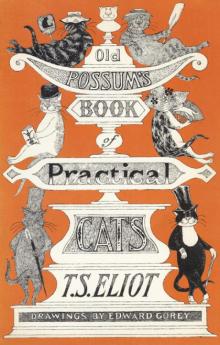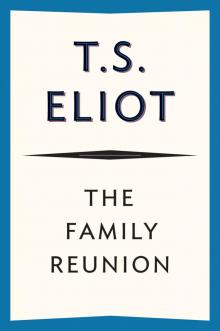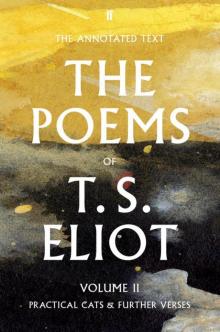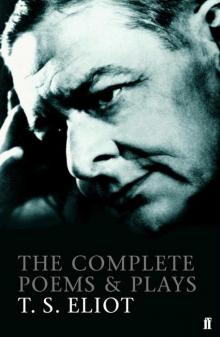- Home
- T. S. Eliot
Letters of T.S. Eliot: 1898-1922
Letters of T.S. Eliot: 1898-1922 Read online
THE LETTERS OF
T. S. ELIOT
EDITED BY
VALERIE ELIOT
AND
HUGH HAUGHTON
VOLUME 1
1898–1922
REVISED EDITION
GENERAL EDITOR
JOHN HAFFENDEN
‘The desire to write a letter, to put down what you don’t want anybody else to see but the person you are writing to, but which you do not want to be destroyed, but perhaps hope may be preserved for complete strangers to read, is ineradicable. We want to confess ourselves in writing to a few friends, and we do not always want to feel that no one but those friends will ever read what we have written.’
from ‘English Poets as Letter Writers’,
an unpreserved lecture given by TSE
at Sprague Memorial Hall, Yale University,
23 November 1933.
This fragment was recorded by his brother.
(MS Houghton)
CONTENTS
Title Page
from ‘English Poets as Letter Writers’
List of Illustrations
Acknowledgements
Introduction
Preface
Biographical Commentary, 1888–1922
Abbreviations and Sources
Editorial Notes
THE LETTERS
Glossary of Names
Index of Correspondents and Recipients
General Index
About the Author
By the Same Author
Copyright
ILLUSTRATIONS
1 TSE aged about three, holding Toby.
Photographer: F.W. Guerin, 12th St. and Washington Avenue, St Louis. Houghton Library MS Am 2560 (154a)
2A The Revd William Greenleaf Eliot, TSE’s grandfather.
Houghton Library MS Am 2560 (251)
B TSE’s birthplace, 2635 Locust Street, St Louis, which no longer exists. Houghton Library MS Am 2560 (262)
3 His parents.
Houghton Library MS Am 2560 (233 [CCE]; 234 [HWE])
4A Ada with Henry. Collection Valerie Eliot
B Henry with TSE. Houghton Library MS Am 2560 (154)
C ‘A baby face with golden promise fraught.’ TSE aged about four.
Photographer: A. S. Robertson, Proprietor, Canova Studio, 3424 Olive Street, St Louis, Mo. Houghton Library MS Am 2560 (155)
5 Daguerreotype of TSE with his sister Margaret.
Collection Valerie Eliot
6 With his Irish nursemaid, Annie Dunne, c.1895.
Houghton Library MS Am 2560 (161)
7A With his mother at East Gloucester, 1895.
Houghton Library MS Am 2560 (158)
B In the schoolyard at the Mary Institute, St Louis, 1896.
Houghton Library MS Am 2560 (156)
8A On the porch at Eastern Point, 1896.
Houghton Library MS Am 2560 (163)
B With T. L. McKittrick, a future President of the World Bank, 1896.
Houghton Library MS Am 2560 (159)
9A With his Hinkley cousins and their nannies on the beach at East Gloucester, 1896. Houghton Library MS Am 2560 (165)
B Eleanor and Barbara Hinkley with TSE in 1897.
Houghton Library MS Am 2560 (167)
10A Charlotte, the sister who painted his portrait.
Houghton Library MS Am 2560 (233)
B His sister Marian. Houghton Library MS Am 2560 (245)
C At the front gate of 2635 on the morning after the cyclone of 27 May 1896, with his mother and, left, cousin Henrietta and sister Margaret. Marian is hidden. Houghton Library MS Am 2560 (162)
11A With his father, 1895. Houghton Library MS Am 2560 (160)
B And in 1898. Houghton Library MS Am 2560 (154)
12 TSE in his bedroom at St Louis, c.1900. Collection Valerie Eliot
13A With his cousins Abigail, Martha and Frederick Eliot.
Collection Valerie Eliot
B At the piano, c.1899. Houghton Library MS Am 2560 (170)
C One of his father’s cat drawings. Collection Valerie Eliot
14A His mother’s bedroom at Locust Street.
Houghton Library MS Am 2560 (262)
B Interior of the house at Eastern Point.
Houghton Library MS Am 2560 (260)
15 Charlotte’s oil portrait (18 x 23in) c.1900–1. TSE is reading a volume of his red Shakespeare set, which remains in his library.
Original in the possession of Theodora Eliot Smith.
Houghton Library MS Am 2560 (172)
16 Aged about twelve. Houghton Library MS Am 2560 (171)
17A The view from the Eliot home at Eastern Point.
Collection Valerie Eliot
B TSE. Houghton Library MS Am 2560 (179b)
C Henry, 1895. Houghton Library MS Am 2560 (236)
18A 1907. Houghton Library MS Am 2560 (177)
B 1908. Houghton Library MS Am 2560 (178)
C On other occasions. Houghton Library MS Am 2560 (179b, 188a)
19A Henry (who is taking the photograph) with his parents at the breakfast table, 4446 Westminster Place, St Louis.
Houghton Library MS Am 2560 (235)
B Henry. Houghton Library MS Am 2560 (236)
C TSE in 1910. Houghton Library MS Am 2560 (179a)
20 Sailing off the Dry Salvages.
21A TSE in the Elsa. Houghton Library MS Am 2560 (219b)
B At the helm with a friend (probably Harold Peters).
Collection Valerie Eliot
22 Jean Verdenal, January 1915. Courtesy of Dr George Watson
23 His mother at her bedroom desk (see letter of 30 December 1917).
Houghton Library MS Am 2560 (233)
24 Etching of Vivien Haigh-Wood as a child, by her father, which she gave to Enid Faber on 23 March 1933. Collection Valerie Eliot
25A Vivien and TSE at 18 Crawford Mansions, 1916.
Collection Valerie Eliot
B In the dining room at Crawford Mansions, July 1916.
Collection Valerie Eliot
26 Tom and Vivien, c.1920. Collection Valerie Eliot
27 TSE with Ottoline Morrell at Garsington, c.1920.
Courtesy Mrs Vinogradoff
28A TSE with Maurice Haigh-Wood, Bosham, Sussex, 26 August 1916. Collection Valerie Eliot
B At the door of South View, Bosham, 1916. Collection Valerie Eliot
29A Vivien, Jeremy and Barbara Hutchinson (on wall). TSE, St John Hutchinson (‘Jack’), Sacheverell and Osbert Sitwell, at West Wittering, Sussex, July 1919. Collection Valerie Eliot
B TSE, Osbert Sitwell, Mary Hutchinson, Jeremy Hutchinson.
Collection Valerie Eliot
30 TSE with his mother at Clarence Gate Gardens, summer 1921. Collection Valerie Eliot
31 TSE and Henry at Itchenor, Sussex, 1921. Collection Valerie Eliot
32 Eleanor Hinkley, 1922. Collection Valerie Eliot
Copyright is reserved in all illustrations.
Photographs 1, 2A and B, 3, 4B and C, 6, 7A and B, 8A and B, 9A and B, 10A, B and C, 11A and B, 13B, 14A and B, 15, 16, 17B and C, 18A, B and C, 19A, B and C, 21A and 23 are reproduced by permission of the Houghton Library, Harvard University.
ACKNOWLEDGEMENTS
I owe a special debt of gratitude to both Dr William H. Bond, formerly Librarian, and Rodney G. Dennis, Curator of Manuscripts, at the Houghton Library, Harvard University; to Dr Donald Gallup, bibliographer of Eliot and Pound, who has answered innumerable questions with grace; and to Matthew Evans with my editor, John Bodley, for their generous support and encouragement.
For permission to print letters and quote from copyright material, I wish to thank Alain Rivière (Alain-Fournier), Alastair Kershaw (Richard
Aldington), Professor Charles W. Eliot (President Eliot), Mme Catherine Gide (André Gide), The Ezra Pound Literary Property Trust, and James Laughlin (Ezra Pound), The Bertrand Russell Estate and McMaster University (Bertrand Russell), Francis Wyndham (Sydney Schiff), Françoise Valéry (Paul Valéry), Harvard University Libraries (J. H. Woods).
I am grateful to Professor John Weightman for translating all letters in French, and to the following for help in various ways: Joan Bailey; Anne Olivier Bell; Kenneth Blackwell, McMaster University; Michael Harry Blechner, McFarlin Library, University of Tulsa; Mary Boccaccio, McKeldin Library, University of Maryland; Dr J. M. L. Booker, Lloyds Bank Archivist; Penelope Bulloch, Balliol College Library; William R. Cagle, Saundra Taylor, Lilly Library; Douglass Campbell; Dr Joseph Chiari; the late Marguerite Cohn; Joyce Crick; Arthur Crook; Roy Davids; Dr A. Deiss, General Secretariat, Swiss Medical Institutions; Giles de la Mare; Peter du Sautoy; Donald D. Eddy, Cornell University Library; Barclay Feather, Director of Libraries, Milton Academy; K. C. Gay, Lockwood Memorial Library, Buffalo; Herbert Gerwing, Special Collections, University of Victoria; Mrs Ghika; R. C. Giles, T. G. Mallinson, Highgate School; Robert Giroux; Sir Rupert Hart-Davis; Professor E. N. Hartley, Institute Archives, MIT; Cathy Henderson, Humanities Research Center, University of Texas; the late Robert Henderson; Dr Roger Highfield, Merton College Library; Robert W. Hill, New York Public Library (Manuscript Division); Penelope Hughes-Hallett; J. W. Hunt, Royal Military Academy, Sandhurst; Lord Hutchinson; Carolyn Jakeman; Professor Dorothy O. Johansen, Reed College, Portland, Oregon; William Jovanovich; Monique Kuntz, Bibliothèque Municipale, Vichy; the staff of the London Library; Richard M. Ludwig, Princeton University Library; R. Russell Maylone, Northwestern University Library; Professor B. K. Matilal; Joe Mitchenson; Mary C. McGreenery, Harvard Alumni Records; Lord Quinton; Angela Raspin, London School of Economics; Benedict Read; Dr R. T. H. Redpath; Helene Ritzerfeld; Rosenbach Museum & Library; Anthony Rota; Samuel A. Sizer, Special Collections, University Libraries, University of Arkansas; Lola L. Szladits, Berg Collection; Theodora Eliot Smith; Kendon L. Stubbs, University of Virginia Library; Barbara Sturtevant; Elizabeth Stege Teleky, Joseph Regenstein Library, University of Chicago; Professor Kathleen Tillotson; Dr George Watson; the late Helen Willard; Professor David G. Williams; Patricia C. Willis, Beinecke Library, Yale University; Dr Daniel H. Woodward, Huntington Library.
It is a pleasure to record my heartfelt appreciation of the Faber team: Ron Costley, designer, Mark Massingham, typesetter, Jane Robertson, managing editor, Hazel Orme, copy-editor, and Gillian Bate, proof reader, who have combined their skills to produce such an elegant tribute to TSE in his centenary year.
1988
The acknowledgements above are those made by Valerie Eliot in the first edition of Volume 1. Sadly, a number of those mentioned are now deceased (as are some of those we will add below). The editors would like also to thank: Owen Barfield; H. Baugh; Jewel Spears Brooker; Robert Brown; Andrew Boxer; Ronald Bush; François Chapon; Mrs Charlton; Alan Clodd; the Literary Trustees of Walter de la Mare; J. P. G. Delaney; the estate of Geoffrey Faber; Toby Faber; Jennifer Formichelli; Mrs Burnham Finney; Estate of Enid Goldsmith; Herbert T. Greene; Warwick Gould; Michael Halls; Saskia Hamilton; Hal Hlavinka; Michael Hofmann; Michael Holroyd; Steven Isenberg; P. D. James; Iman Javadi; Emeline Jouvé; Paul Keegan; Kenneth A. Lohf; Jim McCue; Tessa Milne; Tim Munby; Mary Middleton Murry; Anne Owen; Craig Raine; Carol Rothkopt; Gerd Schmidt; Rev. Karl Schroeder, sj; Ronald Schuchard; Jesse Cordes Selbin; Timothy and Marian Seldes; Prue Shaw; James Strachey; M. J. Tilby; François Valéry, Judith Robinson-Valéry; David Van Ness; Michael J. Walsh; Jemma Walton, J. Waterlow; Dave Watkins; Kieron Winn; Susan Wolfson; John Worthen and Michael Yeats. Special thanks go to Ron Costley, Donald Sommerville for his copy-editing, Jenny Overton for proofreading, Alison Worthington for indexing, and to Debbie Whitfield (PA to Mrs Eliot) for her commitment to this project.
We are grateful in addition to: Leslie Morris and Elizabeth A. Falsey (Houghton Library); Dr P. Kelly (National Library of Scotland); Robin Carlaw (Harvard University Archives); Eamon Dyas (News International); Moira A. Fitzgerald and Eva Guggemos (Beinecke Library, Yale); Thomas Lannon (New York Public Library); Molly Schwartzburg (Harry Ransom Research Center, University of Texas); Claire Nicholas-Walker (British Library); Thomas Whitehead (Temple University Libraries); Stephen Young (Regenstein Library, University of Chicago); Bibliothèque Littéraire Jacques Doucet; Bibliothèque Nationale, Paris; Bodleian Library, Oxford; University of Bonn Library; British Library; Bundesarchiv (German Federal Archives), Koblenz; Rare Books and Manuscripts Division, Butler Library, Columbia University, New York; University of California, Los Angeles; Fondazione Camillo Caetani, Rome; Clare College, Cambridge; Fondren Library, Woodson Research Center, Rice University; Galleria Nazionale d’Arte Moderna, Rome; Harvard University Archives; Special Collections, Isabella Stewart Gardner Museum, Boston, Mass.; Hornbake Library, University of Maryland; Special Collections, Keele University; Modern Archives Centre, King’s College, Cambridge; Magdalene College, Cambridge; Marshall Library, Cambridge; Massachusetts Institute of Technology; Lockwood Memorial Library; University Library, Missouri History Museum; Morris Library, Southern Illinois University at Carbondale; Mugar Memorial Library, Boston University; National Library, Scotland; New College, Oxford; Pennsylvania University Library; Reading University Library; Real Academia de la Historia; Schiller-Nationalmuseum, Marbach am Neckar; Schweizerisches Literaturachiv (Swiss National Archives), Berne; University of Sussex Library; Trinity College, Cambridge; Trinity College, Dublin; University of Virginia Library; Washington University Library, St Louis, Missouri; Widener Library, Harvard University; Chapin Library, Williams College, Williamstown, Massachusetts; Yale University Archives.
2009
The editors and publishers apologise if any person or estate has been overlooked. They would be grateful to be informed if any copyright notice has been omitted, or if there have been any changes of ownership or location.
INTRODUCTION
At the time of our marriage in 1957 I was dismayed to learn that my husband had forbidden the future publication of his correspondence, because I appreciated its importance and fascination. As he often read aloud to me in the evenings – Kim, English and French poetry, Sherlock Holmes, Pickwick Papers, Uncle Remus – I took every opportunity to introduce a poet’s letters, until, eventually, he burst out laughing, and said he would relent on condition that I did the selecting and editing.
When in 1965 I began my research – which was interrupted three years later in order to prepare the hitherto missing manuscript of The Waste Land – the material relating to this volume filled a single folder in TSE’s desk, and many of today’s collections of Eliot letters were still in the hands of their recipients.
The correspondence with Ottoline Morrell did not become available until 1975, and that with Mary Hutchinson until 1977. Very few of their replies have been preserved, and there are none from Brigit Patmore. Letters to Ezra Pound came together at Yale University in stages, except for the last cache, now at the Lilly Library, Indiana University, which was only released in 1982 after a legal dispute. Those to J. H. Woods were given by his widow to Professor David G. Williams, who kindly allowed me to have photostats in 1981. Several unknown early letters to Scofield Thayer were an exciting bonus last year, together with a fair number to Ivor and Dorothea Richards.
Bruce Richmond, like W. H. Auden, threw away letters once they had been answered, and it is known that TSE’s to Lady Rothermere were not kept. I have been unable to trace his correspondence with Charles Whibley, J. M. Robertson or Frederic Manning, but fortunately there are some carbon copies.
On the deaths of his mother and brother, in 1929 and 1947, TSE recovered his correspondence with them and burnt a good part of it, together with their side, thus removing the family record of his final school year, his student days at Harvard and the period in Paris. Furthermore, in his mother’s case, there is a gap bet
ween 23 August 1921 and 12 January 1926, for which she may be partly responsible, having written to him on 8 March 1924 to say that she had all his letters from the time he went to Milton, and supposed she ought to destroy part of them.1
*
As Charlotte Eliot was forty-five when TSE was born, his eldest sister, Ada, who was nineteen years his senior, seemed more like a mother to him. He enjoyed eavesdropping on his siblings’ conversation, although Marian was inclined to say teasingly, ‘Little pitchers have big ears.’ This remark nettled him because at his dancing class one little girl had leaned heavily across him to hiss at another, ‘Look at his ears!’Mortified, he went home and tied them to his head with string.
From his mother, who understood him well, he inherited an anxious, nervous temperament. His father, he felt, was inclined to leave too much to her – such as taking him to the tailor – but no doubt this was partly due to his deafness. When they parted for the last time at the end of his 1915 visit, TSE was convinced that his father thought him a failure. This memory always tormented him, so he was thankful that his mother lived to see him achieve some success.
*
I intended this first volume to run to the end of 1926, which seemed a natural break, and was a biographical span which showed his relationship with several lifelong friends, but the physical extent of the book would, in my publisher’s opinion, have been too bulky for the reader’s comfort. We hope, by publishing the second part next year, to restore the balance. However, the significance of the year 1922, in which The Waste Land was published and The Criterion began, requires no emphasis.

 Old Possum's Book of Practical Cats
Old Possum's Book of Practical Cats The Family Reunion
The Family Reunion T. S. Eliot the Poems, Volume 2
T. S. Eliot the Poems, Volume 2 The Waste Land
The Waste Land The Complete Poems and Plays, 1909-1950
The Complete Poems and Plays, 1909-1950 Letters of T.S. Eliot: 1898-1922
Letters of T.S. Eliot: 1898-1922 The Letters of T. S. Eliot, Volume 1: 1898-1922
The Letters of T. S. Eliot, Volume 1: 1898-1922 Complete Poems and Plays
Complete Poems and Plays